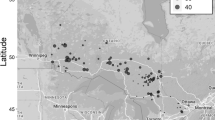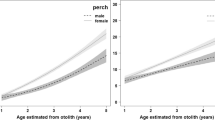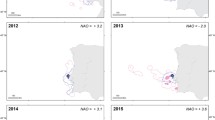Abstract
Fish respond to predation threat by size/cohort-dependent presence in particular habitats and this may contribute to sexual segregation between habitats in species with sexual size dimorphism (SSD). The present study examines the validity of the “predation risk hypothesis” and importance of SSD on habitat (pelagic/inshore) segregation and dietary differences between sexes in three cyprinids with various magnitudes of SSD-roach (Rutilus rutilus), freshwater bream (Abramis brama) and bleak (Alburnus alburnus). Fish were sampled using gillnets over five consecutive years in the Římov Reservoir. Habitat segregation with female overrepresentation in the pelagic habitat was found in the most sexually dimorphic species with 26% bigger females—the roach. When analysis of habitat segregation was size-controlled, this segregation ceased to confirm the importance of SSD. Freshwater bream sexes (2% SSD) differed in diet but did not differ in habitat occupation. Bleak sexes were not segregated. Larger roach individuals (predominantly females) are less threatened by gape-limited predators and consequently they can occupy the risky but optimal (for zooplankton acquisition) pelagic habitat. Our results demonstrate that habitat segregation is present in the species with the most pronounced SSD.




Similar content being viewed by others
References
Andersson, M. B., 1994. Sexual selection. Princeton University Press.
Arendt, J. D., D. N. Reznick & A. López-Sepulcre, 2014. Replicated origin of female-biased adult sex ratio in introduced populations of the Trinidadian Guppy (Poecilia reticulata). Evolution 68: 2343–2356.
Backiel, T. & J. Zawisza, 1968. Synopsis of biological data on the bream. FAO Fisheries Synopsis 36: 121.
Barneche, D. R., C. R. White & D. J. Marshall, 2018. Fish reproductive-energy output increases disproportionately with body size. Science 360: 642–645.
Beier, P., 1987. Sex differences in quality of White-tailed deer diets. Journal of Mammalogy 68: 323–329.
Blabolil, P., D. S. Boukal, D. Ricard, J. Kubečka, M. Říha, M. Vašek, M. Prchalová, M. Čech, J. Frouzová, T. Jůza, M. Muška, M. Tušer, V. Draštík, M. Šmejkal, L. Vejřík & J. Peterka, 2017. Optimal gillnet sampling design for the estimation of fish community indicators in heterogeneous freshwater ecosystems. Ecological Indicators 77: 368–376.
Bowyer, T., 1984. Sexual segregation in Southern mule deer. Journal of Mammalogy 65: 410–417.
Brabrand, Å. & B. Faafeng, 1993. Habitat shift in roach (Rutilus rutilus) induced by pikeperch (Stizostedion lucioperca) introduction: predation risk versus pelagic behaviour. Oecologia 95: 38–46.
CEN EN14757, 2005. Water quality: sampling of fish with multi-mesh gillnets. En 14757:2005 3: 29.
Chapman, B. B., K. Hulthén, D. R. Blomqvist, L. A. Hansson, J. Å. Nilsson, J. Brodersen, P. Anders Nilsson, C. Skov & C. Brönmark, 2011. To boldly go: individual differences in boldness influence migratory tendency. Ecology Letters 14: 871–876.
Conradt, L., 1998. Could asynchrony in activity between the sexes cause intersexual social segregation in ruminants? Proceedings of the Royal Society B: Biological Sciences 265: 1359–1368.
Conradt, L., 2005. Definitions, hypotheses, models and measures in the study of animal segregation. Sexual segregation in vertebrates. Cambridge University Press, Cambridge: 11–35.
Croft, D. P. & M. Krause, 2004. Is sexual segregation in the guppy, Poecilia reticulata, consistent with the predation risk hypothesis? Environmental Biology of Fishes 71: 127–133.
Croft, D. P., J. Krause & R. James, 2005. Predation risk as a driving factor for size assortative shoaling and its implications for sexual segregation in fish. In Ruckstuhl, K. E. & P. Neuhaus (eds), Sexual segregation in vertebrates. Cambridge University Press, Cambridge: 115–126.
Croft, D. P., L. J. Morrell, A. S. Wade, C. Piyapong, C. C. Ioannou, J. R. G. Dyer, B. B. Chapman, Y. Wong & J. Krause, 2006. Predation risk as a driving force for sexual segregation: a cross-population comparison. The American Naturalist 167: 867–878.
Duncan, A. & J. Kubečka, 1995. Land/water ecotone effects in reservoirs on the fish fauna. Hydrobiologia 303: 11–30.
Fox, J. & S. Weisberg, 2011. An R companion to applied regression. Sage, Thousand Oaks, CA.
Garcia, C. M., E. Saborio & C. Berea, 1998. Does male-biased predation lead to male scarcity in viviparous fish? Journal of Fish Biology 53: 104–117.
Geist, V., 1974. On the relationship of social evolution and ecology in ungulates. Integrative and Comparative Biology 14: 205–220.
Griffiths, S. W., J. E. Orpwood, A. F. Ojanguren, J. D. Armstrong & A. E. Magurran, 2014. Sexual segregation in monomorphic minnows. Animal Behaviour 88: 7–12.
Gross, J. E., P. U. Alkon & M. W. Demment, 1995. Grouping patterns and spatial segregation by Nubian ibex. Journal of Arid Environments 30: 423–439.
Hanson, K. C., M. A. Gravel, A. Graham, A. Shoji & S. J. Cooke, 2008. Sexual variation in fisheries research and management: when does sex matter? Reviews in Fisheries Science 16: 421–436.
Haraldstad, O. & B. Jonsson, 1983. Age and sex segregation in habitat utilization by brown trout Salmo trutta in a norwegian lake. Transactions of the American Fisheries Society 112: 27–37.
Holčík, J. & K. Hensel, 1972. Ichtyologická príručka. Vydavaťelstvo Obzor, Bratislava.
Holker, F., 2003. The metabolic rate of roach in relation to body size and temperature. Journal of Fish Biology 62: 565–579.
Hölker, F., S. S. Haertel, S. Steiner & T. Mehner, 2002. Effects of piscivore-mediated habitat use on growth, diet and zooplankton consumption of roach: an individual-based modelling approach. Freshwater Biology 47: 2345–2358.
Jakimchuk, R. D., S. H. Ferguson & L. G. Sopuck, 1987. Differential habitat use and sexual segregation in the Central Arctic caribou herd. Canadian Journal of Zoology 65: 534–541.
Jarolím, O., J. Kubečka, M. Čech, M. Vašek, J. Peterka & J. Matěna, 2010. Sinusoidal swimming in fishes: the role of season, density of large zooplankton, fish length, time of the day, weather condition and solar radiation. Hydrobiologia 654: 253–265.
Kottelat, M. & J. Freyhof, 2007. Handbook of European freshwater fishes. Recherche, Berlin.
Kubečka, J., J. Seďa & J. Matěna, 1998. Fish-zooplankton interactions during spring in a deep reservoir. International Review of Hydrobiology 83: 431–441.
Lammens, E. H. R. R., A. Frank-Landman, P. J. McGillavry & B. Vlink, 1992. The role of predation and competition in determining the distribution of common bream, roach and white bream in Dutch eutrophic lakes. Environmental Biology of Fishes 33: 195–205.
Lenth, R. V., 2016. Least-squares means: the R package lsmeans. Journal of Statistical Software 69: 1–33.
MacFarlane, A. M. & G. Coulson, 2006. Sexual segregation in Australian marsupials. Sexual segregation in vertebrates: ecology of the two sexes. Cambridge University Press, Cambridge: 254–279.
Mackay, I. & K. H. Mann, 1969. Fecundity of two cyprinid fishes in the River Thames, Reading, England. Journal of the Fisheries Research Board of Canada 26: 2795–2805.
Magurran, A. E. & C. Maciás Garcia, 2000. Sex differences in behaviour as an indirect consequence of mating system. Journal of Fish Biology 57: 839–857.
Main, M. B., F. W. Weckerly & V. C. Bleich, 1996. Sexual segregation in ungulates: new directions for research. Journal of Mammalogy 77: 449–461.
Mann, R. H. K., 1973. Observations on the age, growth, reproduction and food of the roach Rutilus rutilus (L.) in two rivers in southern England. Journal of Fish Biology 5: 707–736.
McBride, R. S., S. Somarakis, G. R. Fitzhugh, A. Albert, N. A. Yaragina, M. J. Wuenschel, A. Alonso-Fernández & G. Basilone, 2015. Energy acquisition and allocation to egg production in relation to fish reproductive strategies. Fish and Fisheries 16: 23–57.
Nagy, S., 1987. The food of sterlet (Acipenser ruthenus) in the Czechoslovak–Hungarian section of the Danube. Folia Zoologica 36: 281–287.
Nilsson, P. A. & C. Brönmark, 2000. Prey vulnerability to a gape-size limited predator: behavioural and morphological impacts on northern pike piscivory. Oikos 88: 539–546.
Nunn, A. D., J. P. Harvey & I. G. Cowx, 2007. Variations in the spawning periodicity of eight fish species in three English lowland rivers over a 6 year period, inferred from 0 + year fish length distributions. Journal of Fish Biology 70: 1254–1267.
Parker, G., 1992. The evolution of sexual size dimorphism in fish. Journal of Fish Biology 41: 1–20.
Perrow, M. R., G. Peirson & C. R. Townsend, 1990. The dynamics of a population of roach Rutilus rutilus L. in a shallow lake. Is there a two-year cycle in recruitment? Hydrobiologia 191: 67–74.
Prchalová, M., T. Mrkvička, J. Kubečka, J. Peterka, M. Čech, M. Muška, M. Kratochvíl & M. Vašek, 2010. Fish activity as determined by gillnet catch: a comparison of two reservoirs of different turbidity. Fisheries Research 102: 291–296.
R Core Team, 2018. R: a language and environment for statistical computing. R Foundation for Statistical Computing, Vienna, Austria, https://www.r-project.org/.
Ruckstuhl, K. E., 2007. Sexual segregation in vertebrates: proximate and ultimate causes. Integrative and Comparative Biology 47: 245–257.
Ruckstuhl, K. E. & P. Neuhaus, 2000. Sexual segregation in Ungulates: a new approach. Behaviour 137: 361–377.
Ruckstuhl, K. E. & P. Neuhaus, 2002. Sexual segregation in ungulates: a comparative test of three hypotheses. Biological Reviews of the Cambridge Philosophical Society 77: 77–96.
Ruckstuhl, K. E. & P. Neuhaus (eds), 2005. Sexual segregation in vertebrates. Cambridge University Press, Cambridge.
Rystrom, T. L., V. F. Clement, I. P. Rick, T. C. M. Bakker & M. Mehlis, 2018. Shoal sex composition and predation risk influence sub-adult threespine stickleback shoaling decisions. Behavioural processes. Elsevier BV, New York.
Sano, M., 1993. Foraging activities and diets of males and females in a haremic sandperch (Pisces: pinguipedidae). Marine Ecology Progress Series 98: 55–59.
Seďa, J., A. Petrusek, J. Macháček & P. Smilauer, 2007. Spatial distribution of the Daphnia longispina species complex and other planktonic crustaceans in the heterogeneous environment of canyon-shaped reservoirs. Journal of Plankton Research 29: 619–628.
Shine, R., 1989. Ecological causes for the evolution of sexual dimorphism: A review of the evidence. The Quarterly Review of Biology 64: 419–461.
Slatkin, M., 1984. Ecological causes of sexual dimorphism. Evolution 38: 622–630.
Šmejkal, M., D. Ricard, M. Prchalová, M. Říha, M. Muška, P. Blabolil, M. Čech, M. Vašek, T. Jůza, A. M. Herreras, L. Encina, J. Peterka & J. Kubečka, 2015. Biomass and abundance biases in European standard gillnet sampling. PLoS ONE 10: 1–15.
Stevenson, D. K. & S. E. Campana (eds), 1992. Otolith microstructure examination and analysis. Department of Fisheries and Oceans, Ottawa.
Tamate, T. & K. Maekawa, 2004. Female-biased mortality rate and sexual size dimorphism of migratory masu salmon, Oncorhynchus masou. Ecology of Freshwater Fish 13: 96–103.
Tarkan, A. S., 2006. Reproductive ecology of two cyprinid fishes in an oligotrophic lake near the southern limits of their distributions range. Ecology of Freshwater Fish 15: 131–138.
Trivers, R. L., 1972. Parental investment and sexual selection. In Campbell, T. (ed.), Sexual selection & the descent of man. Aldine Publishing Company, Chicago: 136–179.
Vašek, M., J. Kubečka & J. Seda, 2003. Cyprinid predation on zooplankton along the longitudinal profile of a canyon-shaped reservoir. Archiv Fur Hydrobiologie 156: 535–550.
Vašek, M., O. Jarolím, M. Čech, J. Kubečka, J. Peterka & M. Prchalová, 2008. The use of pelagic habitat by cyprinids in a deep riverine impoundment: rímov Reservoir, Czech Republic. Folia Zoologica 57: 324–336.
Vašek, M., J. Kubečka, M. Čech, V. Draštík, J. Matěna, T. Mrkvička, J. Peterka & M. Prchalová, 2009. Diel variation in gillnet catches and vertical distribution of pelagic fishes in a stratified European reservoir. Fisheries Research 96: 64–69.
Vašek, M., A. P. Eloranta, I. Vejříková, P. Blabolil, M. Říha, T. Jůza, M. Šmejkal, J. Matěna, J. Kubečka & J. Peterka, 2018. Stable isotopes and gut contents indicate differential resource use by coexisting asp (Leuciscus aspius) and pikeperch (Sander lucioperca). Ecology of Freshwater Fish 27: 1054–1065.
Vollestad, L. A. & J. H. L’Abée-Lund, 1987. Reproductive biology of stream-spawning roach, Rutilus rutilus. Environmental Biology of Fishes 18: 219–227.
Wearmouth, V. J. & D. W. Sims, 2008. Sexual segregation in marine fish, reptiles, birds and mammals. Behaviour patterns, mechanisms and conservation implications. Advances in Marine Biology 54: 107–170.
Werner, E. E., J. F. Gilliam, D. J. Hall & G. G. Mittelbach, 1983. An experimental test of the effects of predation risk on habitat use in fish. Ecology 64: 1540–1548.
Wheeler, B., & M. Torchiano, 2016. lmPerm: permutation tests for linear models. R package version 2.1.0, https://cran.r-project.org/package=lmPerm.
Winfield, I. J., 1986. The influence of simulated aquatic macrophytes on the zooplankton consumption rate of juvenile roach, Rutilus rutilus, rudd, Scardinius erythrophthalmus, and perch, Perca fluviatilis. Journal of Fish Biology 29: 37–48.
Wissing, T. E. & A. D. Hasler, 1971. Intraseasonal change in caloric content of some freshwater invertebrates. Ecology 52: 371–373.
Acknowledgements
We thank Martin Čech, Tomáš Jůza, Michal Tušer and Daniel Bartoň for fish-sex determination, Kateřina Soukalová for age determination, Vilém Děd for data processing and all other FishEcU members who helped with data collection http://www.fishecu.cz. We thank Ingrid Steenbergen for English correction and three anonymous reviewers for their insightful comments. The work was supported from ERDF/ESF project Biomanipulation as a tool for improving the water quality of dam reservoirs (No. CZ.02.1.01/0.0/0.0/16_025/0007417) and by Czech Science Foundation P505-12-P647. The work of Jakub Žák from the Department of Zoology, Charles University was partially supported by SVV 260 434/2020.
Author information
Authors and Affiliations
Corresponding author
Ethics declarations
Conflict of interest
All authors declare no conflict of interest.
Additional information
Handling editor: Grethe Robertsen
Publisher's Note
Springer Nature remains neutral with regard to jurisdictional claims in published maps and institutional affiliations.
Electronic supplementary material
Below is the link to the electronic supplementary material.
Rights and permissions
About this article
Cite this article
Žák, J., Prchalová, M., Šmejkal, M. et al. Sexual segregation in European cyprinids: consequence of response to predation risk influenced by sexual size dimorphism. Hydrobiologia 847, 1439–1451 (2020). https://doi.org/10.1007/s10750-020-04198-x
Received:
Revised:
Accepted:
Published:
Issue Date:
DOI: https://doi.org/10.1007/s10750-020-04198-x




